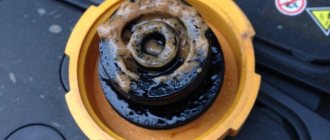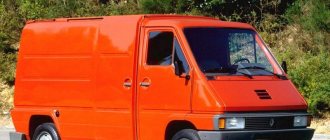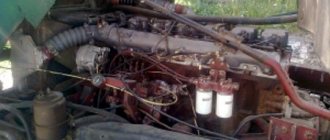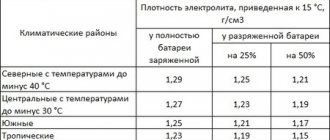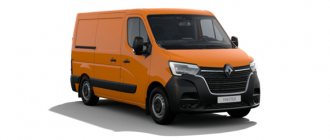For those motorists who have a Renault Logan “iron horse”, it is important to know that the coolant should be replaced every 90 thousand kilometers, or after the car has served faithfully for 6 years. Such parameters and deadlines are set by the manufacturer, and of course, this serves as a guarantee of successful operation of the car.
What kind of antifreeze you need to fill Renault Logan with, how to replace it yourself, and what signs exist for replacing the coolant, you will learn about this and much more from this article.
About types of liquids
- Carboxylate is a type of antifreeze that is endowed with balanced quality conditions, which allows it to be used in different temperature conditions. This category of coolants is traditionally characterized by a high-quality base formula that provides reliable protective properties. Such a refrigerant will eliminate the possibility of unexpected malfunctions in the cooling circuit of the Renault Logan engine during the operating period. Most manufacturers highly recommend or even use carboxylate antifreeze in their car models.
- Hybrid - this type was widely used in the nineties, but even today it is a very popular alternative, preferred by a large category of car owners, including Renault Logan. The liquid has excellent performance in terms of reliability and duration of preservation of its protective properties in terms of elements of the cooling circuit.
- Traditional is a type of liquid that is considered obsolete in comparison with the previous ones, but has good conditioning properties and is capable of maintaining them for a long time during operation.
- "Lobrid" is one of the latest and most promising developments. It takes a worthy place among the leaders in this segment due to the use in its composition of various additives and additives that help improve the protective properties of cylinder blocks and their heads made of aluminum.
We recommend using this particular type of fluid for the engine cooling system in Renault Logan. Although, everyone decides for themselves which coolant to pour into their car.
For many amateurs, the main criterion when choosing antifreeze is its color, which leads to a not entirely correct opinion about the identity of the qualitative properties of different liquids when the color scheme matches. And here again the question arises: what kind of antifreeze should I use? In fact, the color of the refrigerant acts as an indicator in case of leaks from the cooling circuit.
Therefore, if yellow refrigerant is poured into the system in a particular car, this does not mean that it is incapable of combining with red or green liquid. Combination is not a mandatory procedure, although it is better to find out about the variety of colors of liquids suitable for the Renault Logan model from an official representative of the manufacturer.
Malfunctions and methods for eliminating them
The main symptom of a faulty cooling system is engine overheating; in some cases, the engine cannot reach operating temperature (as a rule, in this situation the thermostat needs to be replaced). And another characteristic malfunction is a constant decrease in the level of coolant in the system.
Diagnosis of faults in this case by car mechanics of the Technical Department is carried out visually, and the following is determined:
- the level of antifreeze in the expansion tank (focusing on the MIN and MAX lines), including the color of the coolant and the presence of foreign impurities (doing this yourself, especially with a running, hot engine, is dangerous to health);
- general condition and degree of tension of the pump drive belt (in some cases, the technicians of our technical center replace the pump);
- the absence of particles in the system elements (radiator, fan) that impede the air flow, this is a typical malfunction; in some cases, the radiator may need to be replaced;
- presence of traces of coolant leakage directly in the engine compartment (possible depressurization of the system).
Is the engine overheating or leaking coolant? Contact Technical Services immediately. We have in stock all Logan spare parts necessary for high-quality and prompt repair of the cooling system, which is performed by experienced and qualified craftsmen using modern equipment using special tools.
We work for you seven days a week from 9:00 to 21:00.
We service Renault cars.
Leaks and problems
When replacing coolant, you should pay attention to defects in the hoses; if there is the slightest doubt about their integrity, then you should take care of replacement. It is also advisable to inspect the expansion tank; it is not uncommon for the internal partition to simply dissolve over time and clog the cooling system with flakes of plastic particles
To search for and purchase a barrel, you can use the original number 7701470460 or take the analogue MEYLE 16142230000
It is also advisable to inspect the expansion tank; it is not uncommon for the internal partition to simply dissolve over time and clog the cooling system with flakes of plastic particles. To search for and purchase a barrel, you can use the original number 7701470460 or take the analogue MEYLE 16142230000.
The cover is also periodically changed, original 8200048024 or an analogue ASAM 30937, since the valves installed on it sometimes stick. Increased pressure is created and, as a result, leakage occurs, even in a seemingly serviceable system.
There are cases of thermostat failure 8200772985, improper operation or gasket leakage.
The clamps used in this Renault model also cause criticism from motorists.
They come in two types: low-profile with a latch (Fig. A) and spring-spring (Fig. B). Low-profile with a latch, it is recommended to replace it with a regular worm-type one, since it is not always possible to clamp the original one without a special key. A diameter of 35-40 mm is suitable for replacement.
You can try to put the spring-spring one in place using pliers, but this requires a little skill.
Preparing to replace antifreeze: important tips and tricks
For drivers of a car of this brand, it is better to replace the coolant in advance, namely when it becomes characteristically dirty-brown. In this case, the liquid will become unpleasant and smell sharp, and such changes will occur after 60 thousand kilometers.
To prepare for a simple operation to replace antifreeze, you will need several necessary items, including tools and consumables.
It is important to prepare several types of wrenches, among which there should be open-end and cap options. You should have pliers and a screwdriver on hand. To drain the waste liquid, you need to prepare a wide container with low sides, which would correspond to a volume of 6 liters. Many drivers use the neck of a plastic bottle as a funnel. It is necessary to stock up on rags and cloth or rubber gloves.
Undoubtedly, for convenience, you can use an inspection hole, since in the absence of one you will have to climb under the car and perform all the necessary manipulations while lying on the floor or ground. Before starting work, the engine must be completely cooled, and the valve located at the neck of the expansion tank must be unscrewed to reduce excess pressure in the cooling system. After the cover is removed, you will hear a characteristic sound, after which the cover should return to its place.
Unfortunately, Renault does not have any precautionary plugs or other devices for the release of used antifreeze, so it is drained after removing the system pipes. To begin, remove the lower hose from the radiator, unscrew and remove the tray protecting the crater, then place a container prepared in advance under the radiator. It is more convenient to carry out this work in an inspection hole, then you can throw a board over the hole and install a container on it to collect the waste product.
Please pay attention before replacing!
Coolant has leaked from the thermostat pipe
If you have to completely replace the coolant, then pay attention to the condition of the radiator, pipes, hoses, and thermostat (it is not a very reliable part of the system). Once you have made sure that everything is in perfect order, you can get to work without any problems.
Preparing to fill coolant
After the antifreeze stops leaking, you need to put new clamps with a worm tightening mechanism on the hoses and put the hoses in their original place, after wiping the connection points from dust and dirt with a cloth.
After this, you can fill in new fresh coolant.
Since 2009, the Renault plant has used Glaceol RX Type D as antifreeze, produced under the ELF brand, which is painted yellow and obtained from a concentrate diluted with distilled water in a 1:1 ratio. It is recommended for use in Renault Logan with 1.4 l or 1.6 l engines.
If your Renault Logan has problems with engine cooling, then the first thing to suspect is the thermostat. Watch the video to see which thermostat company to install for Logan.
Renault Logan fuel and lubricant refueling tanks
| Filling/lubrication point | Refill volume | Name of oil/liquid |
| Fuel tank for all engines | 50 liters | Unleaded gasoline with an octane rating of at least 92 |
| Engine lubrication system (including oil filter) engines: | ||
| 1.4 l. 8 valves | 3.3 liters | ELF EVOLUTION SXR 5W30 |
| 1.6 l. 8 valves | ||
| 1.6 l. 16 valves | 4.9 liters | ELF EVOLUTION SXR 5W40 |
| Engine cooling system: | ||
| For all engines | 5.45 liters | GLACEOL RX Type D |
| Transmission | ||
| Manual transmission | 3.1 liters | ELF Tranself NFJ 75W80 or Elf Tranself TRJ 75W-80 |
| Automatic transmission | 7.6 liters | Elf Renaultmatic D3 SYN Elfmatic G3 |
| Power steering | 1 liter | Elf Renaultmatic D3 SYN Elfmatic G3 |
| Brake system | 0.7 liters (with 1 liter pumping) | ELF 650 DOT 4 |
What and how much to fill in Renault Logan
Engine lubrication system.
Logan is equipped with only three engines: 1.4 liters. 8 valves; 1.6 l. 8 valves; 1.6 l. 16 valves.
If we take the first two engines (1.4 l. 8 valves; 1.6 l. 8 valves), then their volume does not change (3.3 l.) and neither does the oil (ELF EVOLUTION SXR 5W30). But in the case of 1.6 liters. 16 valves, then the oil (ELFEVOLUTION SXR 5W40) and volume (4.9 liters) change.
Engine cooling system.
Here you already need to pour the same antifreeze into all engines: GLACEOL RX Type D, and the volume also does not change - 5.45 liters. Before using antifreeze, it must be diluted with distilled water, the proportion is one to one. In this case, your liquid will solidify only at a temperature of -36 degrees.
Fuel.
The tank has a volume of 50 liters, you need to pour gasoline of at least 92 octane.
Transmission
For manual transmissions, ELF Tranself NFJ 75W80 or Elf Tranself TRJ 75W-80 oil is used, and the fill volume is 3.1 liters.
For the automatic transmission, Elf Renaultmatic D3 SYN Elfmatic G3 oil is used, and 7.6 liters will need to be filled.
The hydraulic booster uses Elf Renaultmatic D3 SYN Elfmatic G3 fluid and needs to be filled with 1 liter.
Brake system.
The brake fluid you need to use is ELF 650 DOT 4, this fluid is well suited for this car and you need to fill it in 0.7 liters, if you fill it with bleeding, it will take one liter.
Causes of leaks
Antifreeze leaks are a fairly common problem that requires immediate attention. Even minor leaks can turn into serious leaks at the worst possible time. As a result, the engine overheats, which leads to problems with the motor.
It is important not only to find the place where the leak occurred, but also to completely eliminate the cause
The engine cooling system consists of a number of elements, as well as connecting pipes. Antifreeze, which is a mixture of water and coolant, heats up as the internal combustion engine heats up. As a result, the causes of leaks can be:
- defects in connections responsible for tightness and tightness;
- problems with the elements of the cooling system;
- wear of elements;
- mechanical damage to the elements of the car cooling system;
- errors when assembling elements after repair work;
- violation of the rules for using a car;
The primary sign that there is a problem in the system is the level of antifreeze in the expansion tank. Its constant decrease indicates leaks.
A characteristic sign of a leak is wet spots and collected drops. If this cannot be detected by visually inspecting the parts, then all components of the cooling system should be checked.
More serious problems with antifreeze leakage include cracks in the block and cylinder head. Such a defect can lead to antifreeze entering the internal combustion engine cylinders, leading to mixing of coolant with engine oil. As a result, the antifreeze level drops and the lubricant loses its properties. It is necessary to immediately eliminate the problem, as the unit wears out and may jam and fail.
In conclusion, it is worth noting that in order to avoid breakdowns, leaks and the need to completely replace antifreeze on Renault Logan, you should not add water to the antifreeze when the fluid level decreases in the cold season. The percentage ratio of the required concentration is violated, which leads to freezing of the coolant in the system. The risk of damage to the cooling system and engine failure increases.
Why is it important to change the coolant?
Automotive fluids contain not only mixtures of ethylene glycol and monohydric alcohols, but also anti-corrosion additives. Depending on the type of corrosion inhibitors, coolants are divided into:
- G-11 – based on silicate or nitrite additives.
- G-12, G-12 – based on carboxylic acids.
- G-12 – includes organics and mineral inhibitors.
Mixing all types is not recommended, although the first two are, in principle, allowed. However, it should be taken into account that the service life of the coolant in this case is reduced. Why all these subtleties? The fact is that over time, the properties of chemical additives are lost, and ethylene glycol paired with water begins its corrosive activity. This threatens:
- Possibility of thermostat jamming due to the presence of corrosion products.
- Destruction of the water pump impeller.
- Depressurization of pump bearings.
- Clogged radiator and internal combustion engine channels.
All of the above factors will certainly lead to overheating of the engine, resulting in excessive fuel consumption and a decrease in power. Regular overheating reduces the operational life of the power unit several times.
Such consequences can be avoided by timely replacement of the antifreeze that has expired in full with Renault Logan. In addition, it is important to monitor its condition by periodically looking into the expansion tank.
Replacement frequency, what antifreeze to fill
If you fill in the original liquid, then it will of course be Renault Glaceol RX type D, code 7711428132 liter bottle. But if you can't find it, don't be upset.
Renault Sandero can also be filled with other antifreezes from the factory, for example, Coolstream NRC, SINTEC S 12+ PREMIUM. It all depends on the place of production of the machine and the concluded supply contracts. Since it is expensive to transport “water” from abroad, it is cheaper to use what is produced by local enterprises.
You shouldn’t save money and fill Sandero Stepway with antifreeze, especially since the savings won’t be significant.
If we talk about analogues or substitutes, then any brand that has Type D approval recommended by the French automaker will do.
Antifreeze for new cars
Many people are interested in what kind of antifreeze is poured into Renault during factory assembly. According to the technical documentation of Renault Logan, this model uses Type D concentrate. This is a special liquid developed according to the proprietary standards of the French automaker. The material is green in color and the crystallization temperature is -40 °C. The liquid contains inorganic inhibitors based on silicate or phosphate. Its average service life is about 3 years.
How to add antifreeze to Renault Logan
In order to fill this brand of car with new antifreeze, you will definitely need the following tools:
- Spanners
- Pliers
- Screwdriver Set
- Container for draining used coolant
- Funnel for adding new antifreeze
- Various rags for removing stains
Naturally, it is recommended to carry out such work using an inspection hole. If this is not possible, then the replacement should be made while lying under the car. You should immediately warn that the engine should be cold by this time.
It is not recommended to add antifreeze - it is better to change it
So, to replace antifreeze you need to do the following:
- First of all, you need to relieve excess pressure from the cooling system. To do this, remove the cap of the expansion tank. After releasing excess air, you need to screw the cap back on.
- Then you need to remove the crankcase protection and substitute the previously prepared container. This is where used antifreeze will be drained.
- Next you need to remove the pipe. In the case where there are branded clamps on the hoses, they should be replaced with new ones, as they wear out very quickly
- After this, the hose should be removed from the fitting and led to a container for draining
- Next, unscrew the cap from the expansion tank and the plug from the vertical fitting, which is located on the wide pipe. After these actions, the antifreeze should drain more intensively
- It should be noted that this method cannot completely remove old antifreeze from the cooling system, since it will remain in the cabin heater. In order to completely free the system from old fluid, you need to do the following: loosen the clamps, pull the pipes that are located on the thermostat body to a container for collecting antifreeze
- After the old coolant has completely leaked out, you need to put everything back together.
- New coolant should be filled through the expansion tank. You need to make sure that the drain plug is removed.
- Filling should be done evenly, without jerking, until a stream begins to flow from the fitting
- After this, you need to tighten the fitting and fill in the required amount of antifreeze.
- The level of the poured liquid should be exactly halfway between the “minimum” and “maximum” marks.
How should you choose?
In addition to European coolants, you can find products from America and Japan, which may have the same color scheme. Let us immediately make a reservation that the colors of these manufacturers do not mean that their compositions match. You can mix antifreezes of different colors, but of the same composition. This will be indicated on the label of the coolant canister.
The vehicle's operating manual indicates the coolant approval class, which is also on the label. The main criterion for which it is impossible to combine them is the use of additives of different composition. If you accidentally mix two completely different types of coolant, you can get a violent chemical reaction. As a result, a precipitate may form or flakes may form, after which it will become unsuitable for further use.
How to bleed air from the cooling system of a Renault Logan car
After adding antifreeze, you need to bleed excess air from the system. To do this you need to do the following:
- Start the engine and let it run at idle speed. Warming up should be done to a temperature of forty degrees. After this you need to turn off the engine
- Next, you need to eliminate excess pressure in the system. You need to open the expansion tank
You should also remove the plug from the fitting. Air will escape, and after some time liquid will begin to flow from the fitting. After this, of course, you should tighten the cap of the expansion tank
- Next, you need to get rid of the air in the radiator. To do this, turn on the engine again and warm it up at high speeds - two thousand revolutions per minute. Warm-up time: five to ten minutes
- Bleed the air from the fitting again. Only this time you shouldn’t cover the expansion tank with a brush. These steps must be repeated two or three times
How to flush the cooling system in Logan and replace the coolant?
When the car owner has already decided which coolant to fill, you can move on to the next stage. Before replacing, you should give the engine time to cool, and then unscrew the filler plug on the radiator, thereby ensuring that the system is depressurized.
We install the car on an overpass or pit (you can use a lift). Removes the plastic protective panel of the pallet. We disconnect the pipe from the lower outlet of the radiator and drain the coolant into a specially selected (according to capacity) container. To ensure that the liquid is drained completely, you should unscrew the plug on the motor block (if it is structurally absent, disconnect the pipes from the thermostat housing). When flushing the system, we assemble the circuit together (we connect the previously removed pipes) and fill it with distilled water (it is possible to use a special cleaning additive). We start the Renault Logan engine and load it with various modes for a certain time (depending on the type of “flushing”)
Using the previously described technology, we disassemble the circuit, drain the flushing liquid, and put it back together (pay attention to the careful tightening of the clamps on the pipes). We fill the system with refrigerant, observing the recommended level
We start it up and check the circuit for leaks. Attention! When using concentrate, pay attention to the manufacturer's instructions regarding the proportions for preparing the mixture (with distilled water).
Low-quality antifreeze can cause harm to the elements of the cooling circuit - cause pockets of corrosion and contribute to the acceleration of the formation of deposits. It is better to immediately and permanently decide which antifreeze to fill.
Drawing conclusions
Like any Renault Logan car, engine capacity 1.4 and 1.6 needs attention and quality service. It is recommended to change the coolant every 2 years. You definitely need to pay attention to what kind of coolant you will be pouring into your car. This operation is not difficult to perform, so you can do it yourself. You should choose high-quality refrigerants, paying attention to the compatibility of this liquid with the modification of your car, because a lot depends on what kind of antifreeze you use.
What antifreeze to use for Renault Logan
First, you should clearly understand the following rule: you should only pour coolant into a clean system. This will allow the new antifreeze not to lose all its qualities when mixed with a used product.
Its chemical composition contains the substance ethylene glycol, distilled water and additives consisting of components such as an aqueous solution, glycerin and alcohol. Ethylene glycol and water are the basis of the liquid, which makes up 96 percent of the total volume, the rest is additives. They help combat corrosion in a wide range of radiator cooling systems, namely those made from cast iron, copper and aluminum.
Before using the concentrate, it must be diluted with distilled water in a ratio of 50X50. And as a container for dilution, you can use plastic bottles of one and a half or two liters. The resistance to winter temperatures of the finished antifreeze inspires confidence; it does not freeze at -35.40 degrees below zero. By changing the dilution ratio, for example to 30x70, you can operate the car in different climatic zones.
Antifreeze from the manufacturer Total is safe for plastic and rubber products, as well as for containers painted with paint or varnish. In order to completely fill Renault Logan with new coolant, it is necessary to prepare 608 liters of working product the day before, its quantity depends on the appetite of the engine. You can get this amount of antifreeze by purchasing at least 3-4 liters of concentrate. The remainder will be used for refilling during use of the car, so you should always have it in the trunk.
Antifreeze type GLACEOL RX Type D costs from 330 to 350 rubles per liter, but it is advisable to purchase from trusted sellers or official dealers so as not to “run into” a fake. Distilled water is also sold in specialized auto stores and can be purchased without any problems.
Antifreeze selection criteria
Some car owners mistakenly choose coolant based on its color. This indicator is not decisive, since the color of antifreeze does not depend on its base, but is achieved through special dyes. The following criteria are more important:
- composition brand. The most popular compositions are G11, G12 and G12+. As a rule, G11 antifreezes are used during the initial maintenance of new Renault Logan cars, so these fluids are recommended for use during subsequent maintenance;
- minimum operating temperature. This indicator is especially important if the car is operated in severe frosty climates, where temperatures in winter can drop to extreme values. Various concentrates can withstand frosts of -40...-80 °C. In mild climates, they can be diluted with distilled water, but the frost resistance of the antifreeze will deteriorate somewhat;
- compatibility. When adding coolant, it is recommended to use a compound of the same brand that is already poured into the system.
Drain the old fluid
The pipe in the Renault Logan is removed when the lock nut is first removed from the tightening clamp. Recommendation: if the hoses are secured with original Renault clamps, then they are replaced with new ones, since the old ones are disposable. Afterwards, the hose is twisted from the fitting and lowered into the container. The waste will drain in parallel from the pipe and the radiator. Then remove the cap of the expansion barrel and the plug from the vertical fitting located on the wide pipe fitting to the body of the thermostat. This is to increase the intensity of antifreeze drainage. And the coolant is replaced correctly and faster.
Due to the design features of the Renault Logan cooling system, these actions will not allow all the coolant to drain. A certain amount of it will remain in the radiator of the interior heater. To completely drain the waste, the pipes are unlocked and the clamps are removed from the two hoses that go to the thermostat, and the tubes themselves are lowered into the drain container. Then the cooling system is purged using compressed air supplied through the neck of the expansion tank and the holes in the thermostat housing. The operation is performed carefully without excessive pressure. Otherwise, the honeycomb of the interior heater radiator may be deformed.
After a certain time, during which the cooling system is completely empty, you can reinstall all components. All hoses are returned to their original places and secured with new clamps. Afterwards, new coolant is poured in, but which brand is decided by each individual. For some time, the Renault automaker filled the system with GLACELFAUTOSUPRA antifreeze from the TOTAL brand, painted in a bright yellow and pure yellow color spectrum. Since 2009, when antifreeze is replaced, GLACEOLRXTypeD, produced under the ELF brand, is poured into the system. It has a yellow tint, and before filling, the concentrate is diluted in a 1:1 ratio with distilled water for any volume. These two brands of antifreeze are characterized by excellent quality and are used for use on the French sedan Renault Logan with a 1.4 and 1.6 liter engine. They are purchased from the official Renault distributor. When replacing antifreeze, many are interested in the volume, it is within 5.5 liters, and the color of the liquid is determined through an Internet search. The outer packaging can be viewed in the corresponding video.
Selection of substance
As a coolant, vehicles must be filled with substance type D – GLACEOL RX. The liquid has a yellow color and medium viscosity. Also, in some Renault models, depending on the location of assembly, Cool Stream 4030 Premium coolant can be used as a replacement. In fact, hue in no way determines the characteristics or properties of a substance.
The total volume of the entire cooling system in Renault Sandero 1.6 cars, no matter what year of production they are, is 5.45 liters. There are marks on the expansion tank that can be used to determine how much substance is in the system. It is possible to purchase a concentrate for replacement and then dilute it with water. Catalog numbers of original substances for Renault Sandero cars with a 1.6 liter engine are 7711170545 and 7711170546.
As alternative options, like Febi Korrosions Frostschutmittel, LUKOIL, Liqui Moly KFS 2001, Bizol Antifreeze G12+. This is not a complete list of different types of antifreeze, however, the listed options have demonstrated the best performance during operation of Renault Sandero vehicles. A prerequisite is the use of type D. When mixing different types of coolant, whatever the proportion, the operation of the entire system may be disrupted, the antifreeze may thicken, which will lead to the formation of plugs in the system and a negative impact on the Renault Sandero pipeline.
Instructions for filling the system
Using a funnel, new antifreeze is poured into the Logan system through the neck of the expansion tank - the drain plug must be unscrewed. You should pour slowly, taking pauses, during which you should press all the pipes with your hands to remove air pockets. The process continues until a stream flows from the fitting.
At this moment, you need to quickly remove the funnel from the neck and close it with your right hand, stopping the liquid from flowing out. With your left hand, tighten the fitting plug and add the required amount into the expansion tank. The level should be located between the minimum and maximum marks.
The next step is to release air from the cooling system:
After making sure that the clamps are tight and the plugs are tightened, start the engine
Warm it up for a few minutes at idle speed to a temperature no higher than 400 and turn off the engine. Before bleeding air after replacing the fluid, it is necessary to eliminate excess pressure in the system by unscrewing the expansion tank plug. Attention! The system operates under pressure: always operate with caution, especially when the engine is hot. If you unscrew the lid quickly, hot air will splash out and burn your hands. Covering the expansion tank with your right hand, unscrew the fitting plug with your left hand, remove your hand from the neck of the tank. As soon as the air comes out and liquid flows from the fitting, close the filler hole again and screw the drain valve plug into place
Screw and tighten the reservoir cap securely. Since the Logan stove radiator is located slightly higher than the rest of the cooling system, air will still remain in it. To get rid of it, a new one should be pumped in under pressure created by a water pump. You need to start the engine again and warm it up for 5–10 minutes at high speeds (up to 2000 rpm), monitoring the temperature sensor to avoid overheating of the power unit. Repeat bleeding the air from the fitting, only now do not cover the neck of the tank with your hand, but twist and unscrew its cap to avoid burns to your hands. The procedure will have to be repeated 2-3 times, only then you can drive.
After replacement, there may be residual air in the system for a long time. This may be indicated by temperature fluctuations or insufficient heating in the car interior. Therefore, while driving, air can be periodically removed, as described in the video:
If there is a need to flush the Renault Logan cooling system, then you can follow the instructions described; only after filling in the flushing fluid does it make sense to carefully remove the air plugs. It is enough to let the engine run for a while without allowing it to overheat.
Design features
The main elements of the cooling system of a French car are:
- cooling fan (note that the Logan fan is electrically driven);
- a centrifugal pump with blades, its operation is ensured by a toothed belt drive (timing belt), directly from the crankshaft pulley, providing forced circulation of cooling fluid (usually antifreeze);
- Logan radiator made of aluminum alloy, equipped with an expansion tank, provides cooling of the liquid and removal of excess liquid formed during heating;
- Renault Logan thermostat regulates the supply and temperature of antifreeze;
- power sensor;
- heater radiator (another name for heater radiator), needed to cool the fluid in the heater;
- hoses (radiator outlet and inlet, as well as heater radiator, steam outlet, filler), pipes (cylinder head exhaust) and connectors for connecting all system components.
Currently reading: Which right-hand drive to install on Renault Logan
The operating principle is based on the fact that cooled liquid is supplied directly from the radiator to the system, directly to the pump. The pump pumps antifreeze under pressure to the cylinder block and other components of the power unit. The liquid cools the engine and is supplied to the thermostat; if its temperature does not exceed the set one (89°C), then the thermostat is closed.
Then the antifreeze is supplied to the heater, cooled by the heater radiator, transferring heat to the cabin if necessary, again supplied to the pump and the cycle repeats. This is the so-called small circle of circulation. If the temperature of the coolant exceeds the set one (89°C), the thermostat partially opens (the thermostat can open completely when the antifreeze temperature is above 95°C), it enters the radiator, where it is cooled using the air flow that is formed when the car moves and the fan operates with electric drive, and again supplied to the pump, the cycle repeats. This is a large circle of circulation.
Excess liquid formed during heating enters an expansion tank equipped with an inlet and outlet valve, and antifreeze is poured into it.
Another big problem is air in the cooling system. It is released using a fitting during refueling.
On modifications equipped with air conditioning, repair of the cooling system has a number of differences that our technical center technicians take into account when working.
Replacement frequency, what antifreeze to fill
The original Renault Glaceol RX Type D antifreeze is suitable for all cars produced by this company. You can also use Coolstream NRC; it has official approval and is also used for filling on conveyors located in Russia.
If necessary, you can look for analogues that meet the requirements of the RENAULT specification 41-01-001/-T Type D or with Type D approval.
Sometimes Logan owners use regular G12 or G12+ antifreeze, although the automaker does not make such a recommendation. Therefore, it is difficult to say how they will behave and whether there will be problems when using them.
Reviews
Nikolai, 30 years old Good antifreeze, does not freeze even in the most severe cold. It has to be changed every two to three years. Overall I recommend it.
Maxim, 24 years old I have no complaints about this refrigerant, the only negative is the inflated price.
Yuri, 40 years old I always use this original antifreeze as I try to take care of my car and use only original products.
Evgeniy, 53 years old Having studied reviews on the Internet, I still could not understand how this coolant differs from analogues except for the price. Antifreeze may be good, but its cost is not justified.
Removing old fluid
Do not attempt to pull off the lower radiator hose without first loosening the tension clamp. When removing the locknut, you need to inspect the clamp. If it is original, it will have to be replaced. The French automaker supplies disposable clamps.
Next you need to proceed in the following order:
- The hoses are removed from the radiator and the expansion tank pipe. This will allow you to quickly drain the Renault Logan antifreeze and ensure a high-quality replacement in the future.
- Due to the design of the car, simply disconnecting the hoses will not completely get rid of antifreeze. Some of it will remain in the radiator. To completely remove antifreeze, you need to remove the tubes from the thermostat hoses and lower their container with the drained liquid.
- The cooling system is purged using a compressor. Air must be supplied simultaneously - through the expansion tank and thermostat hoses. The pressure should not be excessive to prevent damage to the radiator honeycomb.
- After the cooling system is completely empty, you can return all hoses and clamps to their place.
After the procedures have been completed, you can begin to fill in new fluid. The choice of antifreeze is up to the car owner. There was a time when Renault engineers recommended using antifreeze called GLACELF AUTO SUPRA produced by Total. It is easily recognized by its orange color. But today the automaker recommends using Renault Glaceol RX Type D. Antifreeze of this brand is available in the form of a concentrate, and before filling it must be diluted with distilled water.
Preparing for work
Coolant is necessary to remove excess heat from a running engine. The productivity of the Renault Logan engine depends on its quality.
Particular attention should be paid to replacing antifreeze
ATTENTION! A completely simple way to reduce fuel consumption has been found! Don't believe me? An auto mechanic with 15 years of experience also didn’t believe it until he tried it. And now he saves 35,000 rubles a year on gasoline! Read more". Today you can buy any coolant in stores, but for a safe replacement you need to choose the one recommended by the manufacturer
You can find out what antifreeze to buy and how much to fill in from the user manual. Every car manufacturer applies it to their products.
Today you can buy any coolant in stores, but for a safe replacement you need to choose the one recommended by the manufacturer. You can find out what antifreeze to buy and how much to fill in from the user manual. Every car manufacturer applies it to their products.
Despite the fact that the French automaker recommends replacing antifreeze after 90,000 km, experienced car enthusiasts insist on a complete replacement of the coolant after a mileage of 60,000 km. The fact is that by this time its color and main characteristics change, it begins to smell unpleasant.
To perform routine maintenance, you will need the following tools and consumables:
- Open-end and box-end wrenches.
- Pliers and screwdriver.
- Low container for collecting antifreeze (at least 6 liters).
- Plastic funnel. If necessary, it can be replaced with the cut off neck of a plastic bottle.
- Fabric gloves.
- Rags.
An important preparation step is removing excess air from the expansion tank. This should be done exclusively on a cold engine. You should remove the cap from the neck of the tank and wait for the air to escape, after which the cap can be returned to its place.
Why this particular material?
It is used as a coolant in most modern imported cars. For domestic cars, antifreeze is used in most cases. Its name translates as “non-freezing” product, so use will be effective at any time of the year, summer and winter, without problems for power units. It is obtained as a result of various additives to the water base of technical alcohols or glycerin.
These can be additives against foaming of the coolant, anti-corrosion inhibitor additives, additives against the formation of air cavities in its composition and some others. One of its main properties, in addition to its freezing temperature, is its expansion coefficient during freezing, which is significantly lower than that of water. Antifreezes are available in several classes, which we will discuss below:
- Coolant G11
is green in color, but blue and yellow colors are also available. This antifreeze is considered a hybrid, as inorganic silicate additives are added. Manufacturers guarantee its working condition for at least 3 years; it is used for all types of cooling systems. Cannot be mixed with other types;
- Composition type G12
has a red color or shades thereof. It is classified as the carboxylate type. The additives in its composition work mainly with areas of the cooling system affected by corrosion. Operation is permitted for 5 years; - Type G13
is most often found in orange. It is based on a propylene glycol base, which is more environmentally friendly compared to previous types, but its cost is much higher than other antifreezes. Best used for high-performance engines. Due to the high cost, production of such products is not organized in the CIS countries.
It is strictly forbidden to mix these materials with each other, and if the coolant is completely replaced, you need to thoroughly flush the cooling system of the power unit.
How to bleed air from the cooling system of a Renault Logan car
After adding antifreeze, you need to bleed excess air from the system. To do this you need to do the following:
- Start the engine and let it run at idle speed. Warming up should be done to a temperature of forty degrees. After this you need to turn off the engine
- Next, you need to eliminate excess pressure in the system. You need to open the expansion tank
You should also remove the plug from the fitting. Air will escape, and after some time liquid will begin to flow from the fitting. After this, of course, you should tighten the cap of the expansion tank
- Next, you need to get rid of the air in the radiator. To do this, turn on the engine again and warm it up at high speeds - two thousand revolutions per minute. Warm-up time: five to ten minutes
- Bleed the air from the fitting again. Only this time you shouldn’t cover the expansion tank with a brush. These steps must be repeated two or three times
How to remove all air from the system
First, you should make sure that all internal plugs have been screwed in. Next is to start the engine. After the engine has warmed up at idle speed and after it reaches 30 degrees, the engine should be stopped. Then the excess pressure is removed. How it's done? The pressure is removed by unscrewing the cap from the inlet side of the engine compartment near the expansion pipe itself.
At the same time, all work on unscrewing and further tightening should be carried out as smoothly as possible without sudden movements, since there is pressure in the system, and it is hot and cool. the mixture can burn your palms. Next, cover the throat with your hand and unscrew the pipe with the other hand. After all the basic manipulations, the palm can be removed. When all the oxygen has gone and the liquid begins to flow, the inlet can be closed and the valve screwed in. Next, tighten the tank cap tightly.
How to properly pour antifreeze into the system
Through the expansion tank and its neck through a funnel, the new product enters the cooling system. Do not rush during the process, gradually push the pipes by hand so that the air plugs come out of them. This process must continue until the liquid flows out of the fitting. After this, the funnel is removed from the neck using the right hand, and the left hand at this time should have time to tighten the screw. The required level of antifreeze is added through the expansion tank.
Make sure that all plugs are screwed in tightly and try to start the engine. It is necessary to warm it up idle and then stop it again.
If this process is too complicated for you, you should contact any car service center.
Features of Sintec Multifreeze antifreeze
If you don’t know what antifreeze to fill, there is no need to waste time deeply studying the technical documentation for the car and searching for a suitable fluid in specialized stores. There is a universal Multifreeze composition from Sintec, which is suitable for almost all models and brands of cars. The liquid has a unique chemical formula and does not contain aggressive substances that can cause corrosion of metals and destruction of seals. Among its main advantages:
- durability. If the cooling system is fully serviced and not contaminated with deposits, the multifreeze can be used throughout the entire service life of the vehicle. You just need to periodically check its condition and make sure that the coolant does not become cloudy (for example, this can happen when oil gets into the cooling system through broken gaskets);
- compatibility with other compounds. Multifreeze can be safely mixed with antifreeze G11, G12, G12+ and G12++ of any color. This is convenient when you need to add coolant to the system, but the car owner does not have information about the brand and type of fluid that is currently used in the car;
- versatility. Sintec Multifreeze coolant can be used in cars of any model and year of manufacture. Its applicability does not depend on the car’s mileage, engine condition and other factors.
